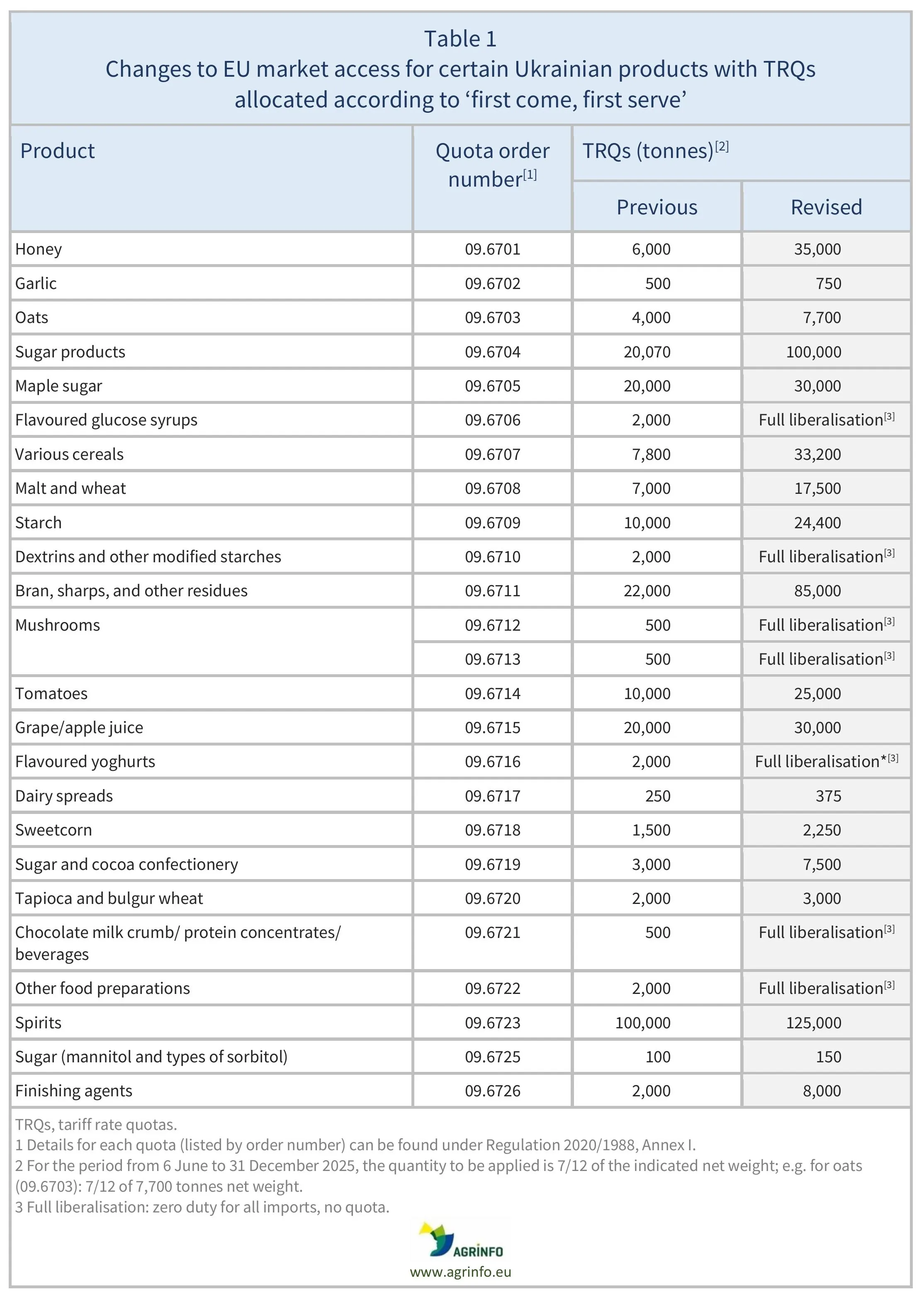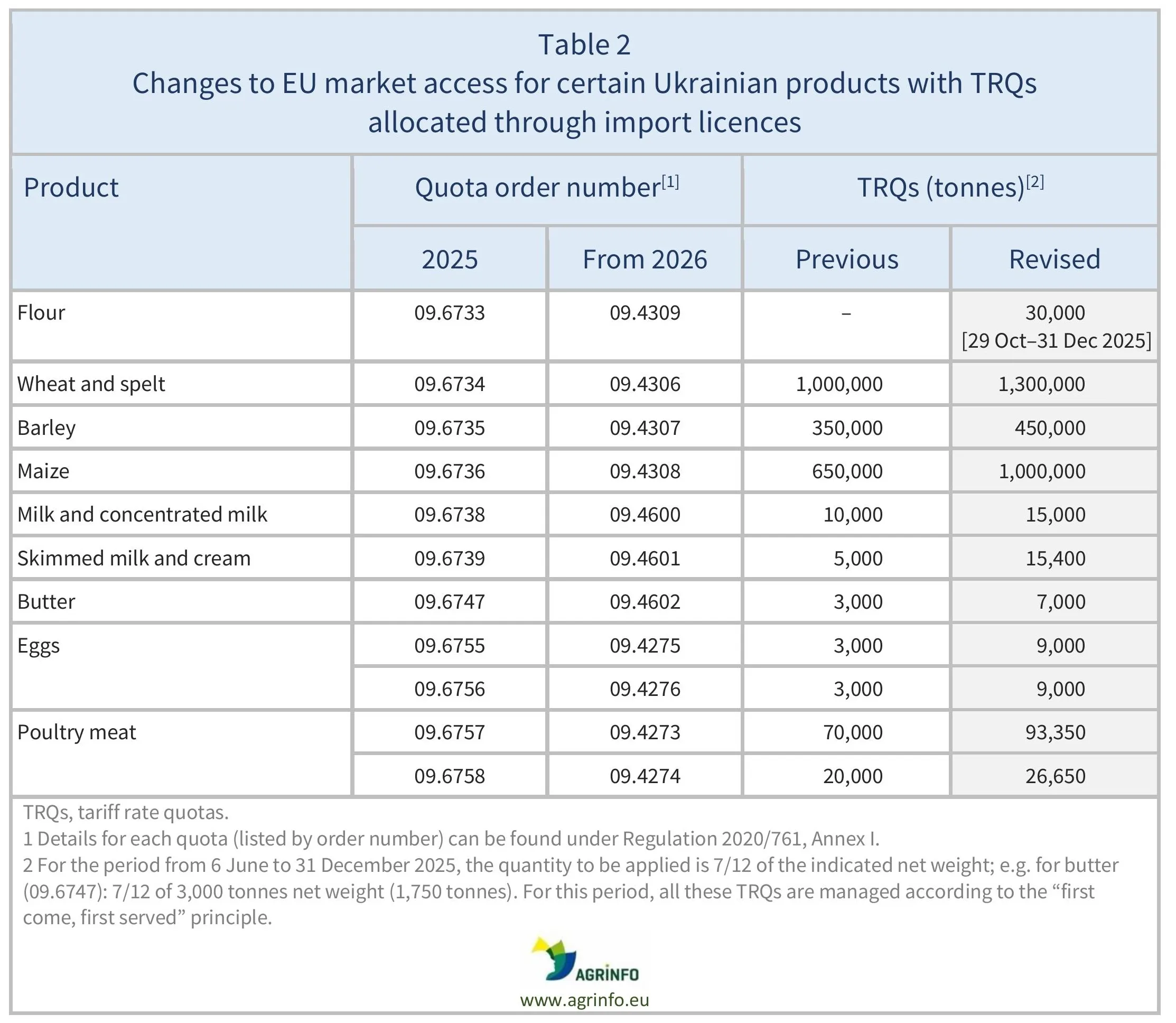Ukrainian tariff rate quotas
- Tariffs & quotas
- Trade
Summary
The revised trade agreement between the European Union (EU) and Ukraine – known as the Deep and Comprehensive Free Trade Area (DCFTA) – applies from 29 October 2025. It provides greater access to the EU market for some Ukrainian products, while limiting EU imports of other products. It also includes a safeguard clause and Ukraine’s commitment to align its national rules on EU production standards by the end of 2028.
Following a period of full trade liberalisation – zero duties and zero quota limitations – on all Ukrainian imports, the tariff rate quotas (TRQs) established under the EU–Ukraine DCFTA were reintroduced on 6 June 2025 (Regulation 2025/1132).
Following further negotiations between the EU and Ukraine, the EU is implementing the following changes (under Regulation 2025/2199):
- full trade liberalisation for chocolate products, dextrins and other modified starches, mushrooms, sugar syrups, yoghurt, and other food preparations
- increased TRQs for certain Ukrainian products
- a new tariff rate quota for flour
- changes to the description of products covered by certain TRQs.
New tariff rate quotas for agri-food products from Ukraine
Commission Implementing Regulation (EU) 2025/1132 of 3 June 2025 amending Implementing Regulations (EU) 2020/761 and (EU) 2020/1988 as regards tariff rate quotas for products originating in Ukraine in 2025.
Commission Implementing Regulation (EU) 2025/2199 of 27 October 2025 amending Implementing Regulations (EU) 2020/1988 and (EU) 2020/761 as regards the quantities that may be imported under certain tariff quotas following the amendment of the Association Agreement between the European Union and Ukraine.
Decision No 3/2025 of the EU–Ukraine Association Committee in Trade Configuration of 14 October 2025 on the reduction and elimination of customs duties pursuant to Article 29(4) of the Association Agreement between the European Union and the European Atomic Energy Community and their Member States, of the one part, and Ukraine, of the other part.
Update
The revised trade agreement between the European Union (EU) and Ukraine – known as the Deep and Comprehensive Free Trade Area (DCFTA) – applies from 29 October 2025. It provides greater access to the EU market for some Ukrainian products, while limiting EU imports of other products. It also includes a safeguard clause and Ukraine’s commitment to align its national rules on EU production standards by the end of 2028.
Following a period of full trade liberalisation – zero duties and zero quota limitations – on all Ukrainian imports, the tariff rate quotas (TRQs) established under the EU–Ukraine DCFTA were reintroduced on 6 June 2025 (Regulation 2025/1132).
Following further negotiations between the EU and Ukraine, the EU is implementing the following changes (under Regulation 2025/2199):
- full trade liberalisation for chocolate products, dextrins and other modified starches, mushrooms, sugar syrups, yoghurt, and other food preparations
- increased TRQs for certain Ukrainian products
- a new tariff rate quota for flour
- changes to the description of products covered by certain TRQs.
Impacted Products
Cereals, maize, wheat, spelt, barley, starch, flour, malt, milk and milk products, butter and fats, dairy, poultry meat, garlic, apple juice, grape juice, tomatoes, mushrooms, honey, confectionery, cocoa, chocolate, sugar and syrup, dextrins, sweetcorn, spirits, finishing agents
What is changing?
The temporary liberalisation of trade in agri-food products entering the EU from Ukraine ended on 5 June 2025. The tariff quotas established for certain agricultural products in the DCFTA were based on an entire year of trade.
For the period 6 June to 31 December 2025, these quotas are recalculated on a pro rata basis taking into account the remainder of the calendar year, that is, 7/12 of the original quota (see Tables 1 and 2).
Certain TRQs are usually allocated through import licences. However, between June and December 2025, allocation followed the “first-come, first-served” principle (chronologically, according to the date the products were placed on the EU market). The allocation of these TRQs will revert to import licences for 2026 (Regulation 2025/2199). Table 2 lists the Ukrainian products concerned by this change of TRQ management.
In October 2025, following negotiations between the EU and Ukraine, the EU (Regulation 2025/2199) is:
- removing TRQs to allow zero duty, zero quota access for chocolate products, dextrins and other modified starches, mushrooms, sugar syrups, yoghurt, and other food preparations
- increasing the quantities of TRQs for 2025 and 2026.
For further details see Tables 1 and 2.
Regulation 2025/2199 also changes the description of the following products (quota order numbers in brackets):
- bran, sharps, and other residues (09.6711)
- sugar confectionery (09.6719)
- wheat and spelt (09.6734)
- barley (09.6735)
- maize (09.6736)
- milk and concentrated milk (09.6738)
- skimmed milk and cream (09.6739)
- raw beet sugar (09.6704)
- maple sugar in solid form (09.6705)
- apple juice (09.6715)
- dextrins and other modified starches (09.6726).
The revised DCFTA also includes a safeguard clause that allows the EU to reintroduce import tariffs if imports cause social or economic disruption within the European Union. Ukraine agrees to align its national rules on EU production standards (animal welfare, use of pesticides, and veterinary medicine) by the end of 2028.
Why?
The Association Agreement between the EU and Ukraine, which includes the DCFTA, is reviewed regularly, aiming to strengthen ties between Ukraine and the EU, to support the Ukrainian economy in time of war, and to support alignment of the country’s agricultural sector with EU standards to facilitate Ukraine’s accession to the EU.
Timeline
The changes introduced by Regulation 2025/2199 apply from 29 October 2025.
Background
In 2022, in response to Russia’s aggression against Ukraine and to support the Ukrainian economy, the EU granted Ukraine full trade liberalisation – zero duties and zero quota limitations – on all goods for a temporary period (Regulation 2022/870). In May 2024, the EU decided that these measures should be extended again until 5 June 2025 (Regulation 2024/1392). This temporary period has now ended.
The amount of import tariff (also known as import duty) that must be paid when importing agri-food products into the EU depends on the product, the trading relationship between the EU and Ukraine, and potentially on the time of year (e.g. for fruit).
The Association Agreement between the EU and Ukraine includes the DCFTA, which sets preferential trading conditions for certain Ukrainian imports. This can be complete liberalisation (zero duty, zero quota) or TRQs. TRQs allow a predetermined quantity of specific Ukrainian products to be imported into the EU at lower import duty rates than are normally applied.
For more information, see Import tariffs and tariff rate quotas explained.
Resources
Regulation 2020/761 laying down rules for the application of Regulations 1306/2013, 1308/2013 and 510/2014 as regards the management system of tariff quotas with licences.
Regulation 2020/1988 laying down rules for the application of Regulations 1308/2013 and 510/2014 as regards the administration of import tariff quotas in accordance with the ‘first come, first served’ principle.
Association Agreement between the European Union and its Member States and Ukraine (29 May 2014).
Regulation 2024/1392 on temporary trade-liberalisation measures supplementing trade concessions applicable to Ukrainian products under the Association Agreement between the European Union and the European Atomic Energy Community and their Member States, of the one part, and Ukraine, of the other part.
Regulation 2022/870 on temporary trade-liberalisation measures supplementing trade concessions applicable to Ukrainian products under the Association Agreement between the European Union and the European Atomic Energy Community and their Member States, of the one part, and Ukraine, of the other part.
Sources
Commission Implementing Regulation (EU) 2025/1132 of 3 June 2025 amending Implementing Regulations (EU) 2020/761 and (EU) 2020/1988 as regards tariff rate quotas for products originating in Ukraine in 2025
Commission Implementing Regulation (EU) 2025/2199 as regards the quantities that may be imported under certain tariff quotas following the amendment of the Association Agreement between the European Union and Ukraine
Decision No 3/2025 of the EU-Ukraine Association Committee in Trade Configuration of 14 October 2025 on the reduction and elimination of customs duties
Disclaimer: Under no circumstances shall COLEAD be liable for any loss, damage, liability or expense incurred or suffered that is claimed to have resulted from the use of information available on this website or any link to external sites. The use of the website is at the user’s sole risk and responsibility. This information platform was created and maintained with the financial support of the European Union. Its contents do not, however, reflect the views of the European Union.
New tariff rate quotas for agri-food products from Ukraine
Commission Implementing Regulation (EU) 2025/1132 amending Implementing Regulations (EU) 2020/761 and (EU) 2020/1988 as regards tariff rate quotas for products originating in Ukraine in 2025.
Commission Implementing Regulation (EU) 2025/2199 as regards the quantities that may be imported under certain tariff quotas following the amendment of the Association Agreement between the European Union and Ukraine.
Decision No 3/2025 of the EU–Ukraine Association Committee in Trade Configuration of 14 October 2025 on the reduction and elimination of customs duties.
What is changing and why?
In 2022, in response to Russia’s aggression against Ukraine and to support the Ukrainian economy, the European Union (EU) granted Ukraine full trade liberalisation – zero duties and zero quota limitations – on all goods for a temporary period.
This liberalisation came to an end on 5 June 2025, and the tariff rate quotas (TRQs) established under the EU–Ukraine Association Agreement were reintroduced.
For the period 6 June to 31 December 2025, these quotas are recalculated on a pro rata basis taking into account the remainder of the calendar year, that is, 7/12 of the original quota.
Certain TRQs are usually allocated through import licences. However, between June and December 2025, allocation followed the “first-come, first-served” principle (chronologically, according to the date the products were placed on the EU market). The allocation of these TRQs will revert to import licences for 2026.
In October 2025, following negotiations between the EU and Ukraine, the EU is:
- removing TRQs to allow zero duty, zero quota access for certain Ukrainian products
- increasing the quantities of TRQs for 2025 and 2026.
The revised Deep and Comprehensive Free Trade Area (DCFTA), which is part of the EU–Ukraine Association Agreement, also includes a safeguard clause that allows the EU to reintroduce import tariffs if imports cause disruption within the European Union. Ukraine agrees to align its national rules on EU production standards (animal welfare, use of pesticides, and veterinary medicine) by the end of 2028.
Timeline
The changes introduced by Regulation 2025/2199 apply from 29 October 2025.
Tables & Figures
Disclaimer: Under no circumstances shall COLEAD be liable for any loss, damage, liability or expense incurred or suffered that is claimed to have resulted from the use of information available on this website or any link to external sites. The use of the website is at the user’s sole risk and responsibility. This information platform was created and maintained with the financial support of the European Union. Its contents do not, however, reflect the views of the European Union.


